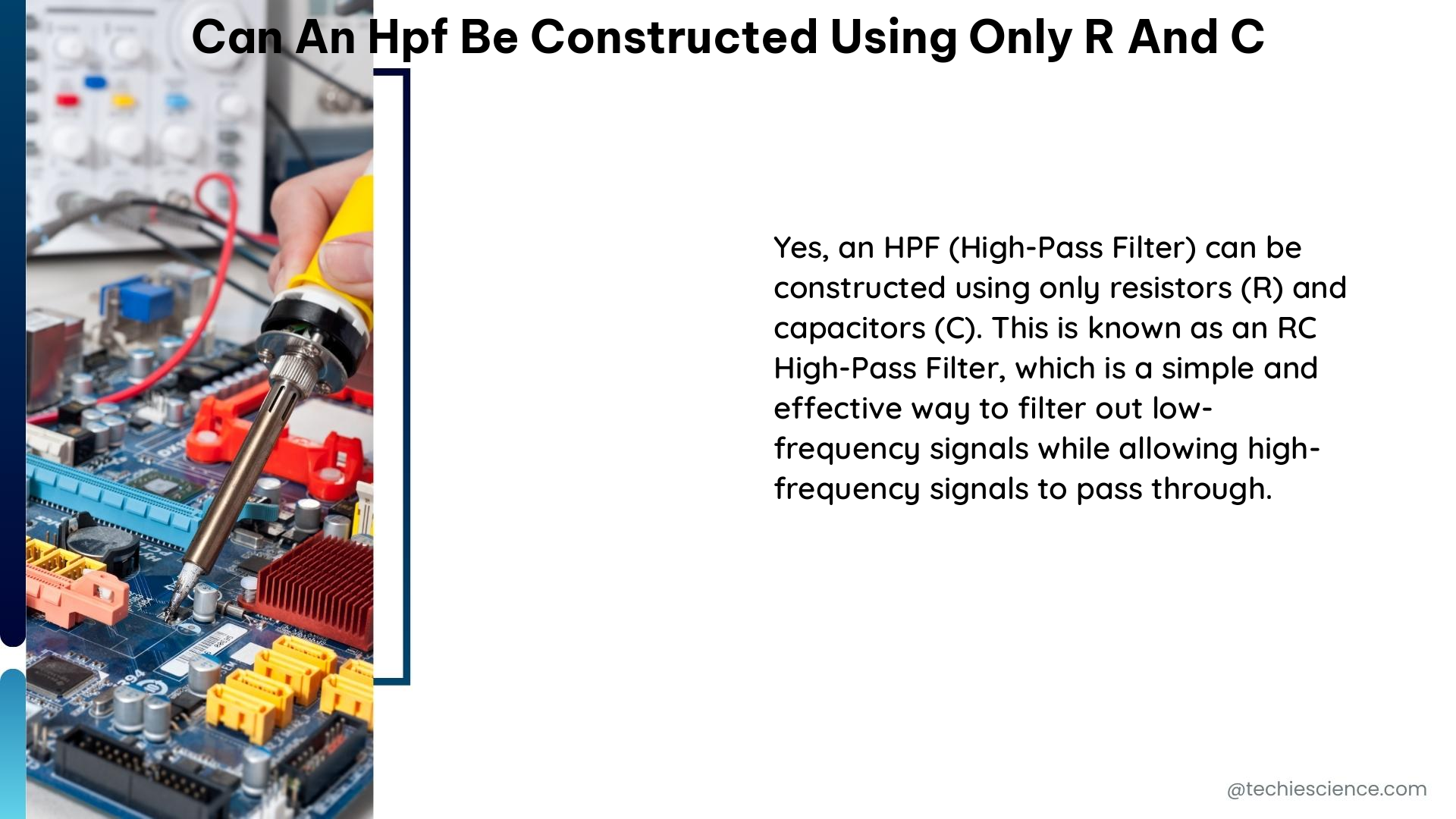An HPF (High-Pass Filter) is an electronic circuit that allows high-frequency signals to pass through while blocking or attenuating low-frequency signals. It is possible to construct an HPF using only resistors (R) and capacitors (C) by taking advantage of the frequency-dependent characteristics of these components.
Understanding the Fundamental Principle of an RC HPF
The fundamental principle behind an RC HPF is based on the fact that a capacitor acts as an open circuit at low frequencies and a short circuit at high frequencies. By combining a resistor and a capacitor in a specific configuration, we can create a filter that attenuates low-frequency signals and passes high-frequency signals.
Constructing a First-Order RC HPF

The simplest form of an RC HPF is a first-order filter, which consists of a series resistor (R) and a capacitor (C) connected in parallel to the output, as shown in Figure 1.

Figure 1: First-Order High-Pass Filter
The cutoff frequency (f_c) of this first-order HPF can be calculated using the following formula:
f_c = 1 / (2 * π * R * C)
Where:
– f_c is the cutoff frequency in Hertz (Hz)
– R is the resistance in Ohms (Ω)
– C is the capacitance in Farads (F)
The cutoff frequency represents the point at which the filter starts to attenuate signals. At frequencies below f_c, the filter’s attenuation increases as the frequency decreases, while at frequencies above f_c, the filter allows signals to pass through with minimal attenuation.
Understanding the Time Constant (τ) of an RC Circuit
The time constant (τ) of an RC circuit is another important parameter, which can be calculated as:
τ = R * C
Where:
– τ is the time constant in seconds (s)
– R is the resistance in Ohms (Ω)
– C is the capacitance in Farads (F)
The time constant represents the time it takes for the circuit to reach 63.2% of its final value when subjected to a step input.
Analyzing the Frequency Response of a First-Order HPF
The frequency response of a first-order HPF can be characterized by its magnitude response and phase response.
Magnitude Response
The magnitude response of a first-order HPF can be expressed in decibels (dB) using the following formula:
|H(f)| = sqrt[(1 / (1 + (f / f_c)^2))]
Where:
– |H(f)| is the magnitude response
– f is the frequency
– f_c is the cutoff frequency
This formula describes how the filter attenuates or amplifies signals at different frequencies.
Phase Response
The phase response of a first-order HPF can be expressed in degrees using the following formula:
φ(f) = arctan(-f / f_c)
Where:
– φ(f) is the phase response in degrees
– f is the frequency
– f_c is the cutoff frequency
This formula describes the phase shift introduced by the filter.
Advantages and Limitations of an RC HPF
One of the main advantages of an RC HPF is its simplicity in design, as it only requires a resistor and a capacitor. This makes it a cost-effective and easy-to-implement solution for various applications.
However, the main limitation of a first-order RC HPF is its relatively gradual roll-off, which means that it may not provide sufficient attenuation of low-frequency signals in some applications. To address this, higher-order HPFs can be constructed by cascading multiple first-order stages or by using more complex filter topologies, such as Sallen-Key or Butterworth filters.
Applications of RC HPFs
RC HPFs find applications in various electronic circuits and systems, including:
- Audio processing: Removing unwanted low-frequency noise or rumble in audio signals.
- Biomedical instrumentation: Filtering out low-frequency artifacts in electrocardiogram (ECG) or electroencephalogram (EEG) signals.
- Sensor signal conditioning: Removing low-frequency drift or offsets in sensor measurements.
- Communication systems: Separating high-frequency and low-frequency components in modulated signals.
- Control systems: Filtering out low-frequency disturbances or offsets in feedback loops.
Conclusion
In summary, an HPF can be constructed using only resistors and capacitors by taking advantage of the frequency-dependent characteristics of these components. The simplest form of an RC HPF is a first-order filter, which consists of a series resistor and a capacitor connected in parallel to the output. The cutoff frequency of a first-order HPF can be calculated using the formula f_c = 1 / (2 * π * R * C), where R is the resistance and C is the capacitance. The time constant of an RC circuit can be calculated as τ = R * C, representing the time it takes for the circuit to reach 63.2% of its final value when subjected to a step input. RC HPFs find various applications in electronic circuits and systems, particularly in signal processing and conditioning.
References:
– Vibration Analysis Dictionary: Terms – Mobius Institute
– Beginner question on LPF and HPF. : r/CarAV – Reddit
– Ultrasound system with iterative high pass filter selection
– Neural Networks as Cybernetic Systems – Part I

The lambdageeks.com Core SME Team is a group of experienced subject matter experts from diverse scientific and technical fields including Physics, Chemistry, Technology,Electronics & Electrical Engineering, Automotive, Mechanical Engineering. Our team collaborates to create high-quality, well-researched articles on a wide range of science and technology topics for the lambdageeks.com website.
All Our Senior SME are having more than 7 Years of experience in the respective fields . They are either Working Industry Professionals or assocaited With different Universities. Refer Our Authors Page to get to know About our Core SMEs.